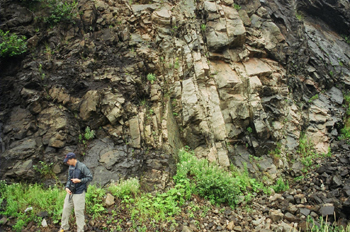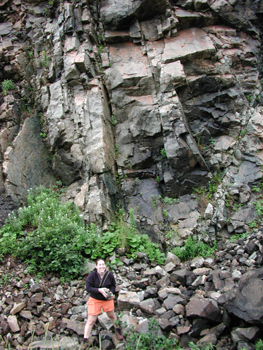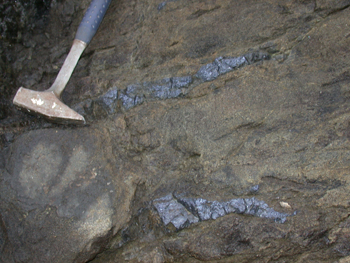Welcome to the Humber Zone
Stephenville is a town on the Port-au-Port Peninsula on the west coast
of Newfoundland. In geologic terms, Stephenville is part of the Humber
Zone. The Humber zone has Grenvillian age basement rocks (~1200 million
years old rock) overlain by Cambrian and Ordovician sandstones, limestones,
and shales. These sedimentary rocks were all metamorphosed and deformed
during the Taconic and Acadian orogenies in the Late Ordovician (~440
million years ago) and Early Devonian (~410 million years ago) respectively.
The basement rocks in the Humber Zone formed during the Grenvillian orogeny about 900 to 1200 million years ago. During the Grenvillian orogeny, the precursor to the North American plate collided with another plate and the collision of these two plates formed a large mountain range similar to the modern Himalayan Mountains. The precursors to the Appalachian and Adirondack Mountains in the eastern United States were built during this orogeny. The collision between the two plates also strongly metamorphosed the existing rocks, forming the high-grade and strongly deformed metamorphic gneiss seen today.
Following this collision, continental rifting occurred. An ocean formed where the continents split apart. This ocean, known as the Iapetus Ocean, existed from the Cambrian through the Ordovician (438 to 570 million years ago). The Cambrian and Ordovician sandstones, limestones, and shales found in the Humber Zone today were deposited along the coast of the Iapetus Ocean.
The Iapetus Ocean began to close during the Ordovician. When it closed completely, the proto-North American continent again collided with another continent. This collision attached crust and rocks unrelated to the Grenvillian Orogeny on the central and eastern parts of what is modern Newfoundland. As a result, Newfoundland can be divided into three sections based on its geology. The western section is the Humber Zone and is associated with the Grenvillian orogeny. The middle section is made up of the Dunnage and Gander Zones and is associated with volcanic rocks from the Iapetus Ocean basin. The eastern most section is called the Avalon Zone and is known as an exotic terrane because the rocks from the Avalon Zone were attached onto Newfoundland only about 410 million years ago.

An outcrop of magnetite banded granitic
gneiss
on the Port-au-Port Peninsula.

